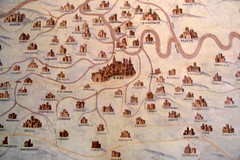
The Centro Europeo di Ricerche Preistoriche in Isernia (Molise) is hosting the new magazine
ArcheoMolise, whose issues now number three. Available
here in .rar and .zip formats, which unpack into pdfs. The journal focuses on the archaeology of Molise, with forays into Colombia, and its chronological scope ranges from the Paleolithic through the present day, as can be seen from the contents:
(Aprile/Giugno 2009, No. 0 - Anno I):- Antonella Minelli et al., 'Isernia La Pineta. Il sito preistorico alla luce delle recenti acquisizioni'
- Ettore Rufo, '40.000 anni fa a Rocchetta a Volturno. Gli artigiani neandertaliani di Grotta Reali'
- Chiara Santone, 'Il ripostiglio di Vinchiaturo. Alcune osservazioni.'
- Sandra Guglielmi & Petronilla Crocco, 'La necropoli di Ripatagliata. Studio antropologico dei resti scheletrici umani rinvenuti a Guglionesi'
- Karicla Scarcella, 'Il carnevale di Cercepiccola. Mesi, stagioni e drammi carnascialeschi'
- Michele Fratino, 'La catapulta sannitica di Casalbordino'
 (Giulio/Settembre 2009, No. 1 - Anno I):
(Giulio/Settembre 2009, No. 1 - Anno I):- Marta Arzarello et al., 'I bifacciali di Monteroduni. Un sito acheuleano di occupazione?'
- Michele Raddi, 'L'alta valle del Volturno. Insediamenti tardo antichi e medioevali'
- Walter Santoro, 'S. Croce di Sepino. Un Eigenkloster della valle del Moschiaturo'
- Luca D'Alessandro, 'Le maitunat' di Gambatesa. Una tradizione secolare'
- Brunella Muttillo, 'Alla riscoperta di El Dorado. La missione archeologica molisana in Colombia'
- Andrea Lonardelli, 'Il costume funerario femminile nel Molise preromano. I casi di Termoli, Guglionesi, Larino, San Giuliano di Puglia, Pozzilli e Gildone'
 (Ottobre/Dicembre 2009, No. 2 - Anno I):
(Ottobre/Dicembre 2009, No. 2 - Anno I):- Lorenzo Quilici, 'Il castello di Gerione presso Casacalenda, da Annibale agli Angioini'
- Adriano LaRegina, 'Ritratto di Caligola, poi di Augusto, dal Molise'
- Giovanna Falasca, 'San Giuliano del Sannio, alla ricerca delle origini storiche'
- Gabriella Di Rocco, 'Insediamenti fortificati del Molise occidentale, tra alto e basso Medioevo'
- Alessandro Testa, 'La Maschera del Cervo a Castelnuovo al Volturno, breve introduzione alla storia ed alle interpretazioni di una pantomima tradizionale'
- Roberta Venditto, 'Un alabastro inglese nel Regno di Napoli. Il caso del polittico del museo archeologico di Venafro'
(I'll be in Cincinnati for the "
Beyond Magna Graecia" conference from tomorrow, Thursday, through Saturday, November 12 - 14. The organizers have helpfully put up a selection of background readings for the conference topic
here.)

























